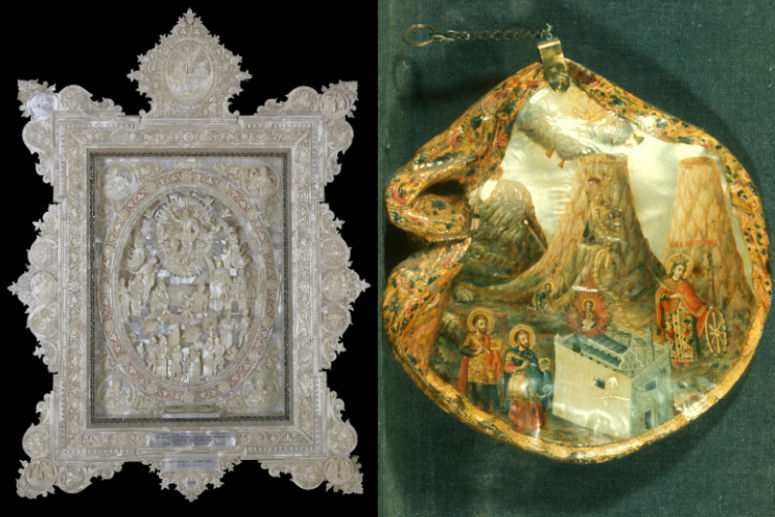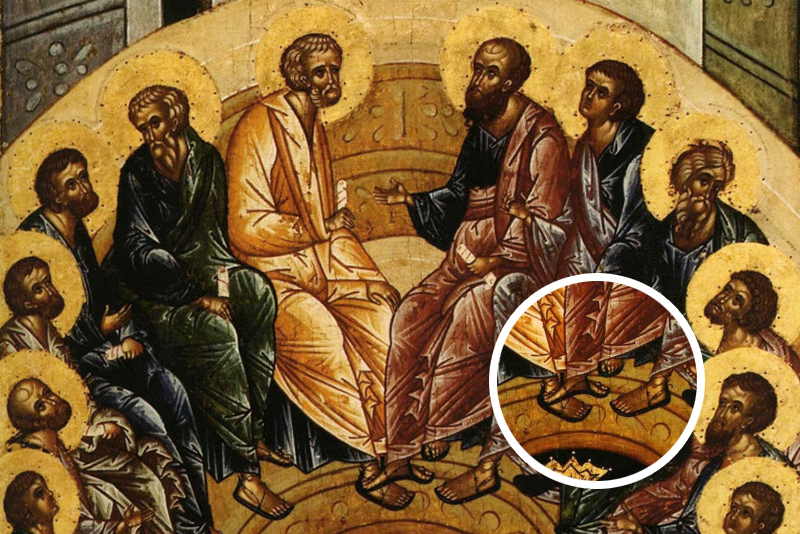
Today when we see carved icons made of wood or ivory, as well as obsidian or stone icons, we consider them unusual. But if we compare these items with some of the traditions and unique examples known from history, they will appear absolutely ordinary. In this article, you will find icons made of bird feathers, dried fish, a crocodile skull and more.
Let’s start with the most “traditional” works and move towards the most unexpected ones.

Here you can see a so-called prayer walnut. Such nuts, decorated with carved miniatures of the events from Sacred History, were popular in Northern Europe in the 15th and 16th centuries. Contrary to the expectations, these prayer nuts were made of wood, and derived their name from the outward resemblance to a walnut, especially in a folded state.
It could take an individual artisan up to 30 years to create one such item. This is for a good reason. The level of detail in some of them allows you to see the feathers on the angels’ wings, as well as the texture of their clothes and jewellery.
A regular photograph cannot capture all the details of this miniature item. The displayed pictures are made by merging several images with different focus points. Needless to say, the number of such walnuts is very limited, and they were available only to the richest people.

Information about these images is scarce. They were made around 1590 from parrot and hummingbird feathers by Juan Bautista Cuiris, a Spanish colonist in Mexico, working in a monastic artisanry school under the direction of Bishop Vasco de Quiroga, a well-known patron of arts and crafts at that time, also popular among the Indians. These items are an example of traditional European imagery, depicted using traditional techniques of Native Americans.

These icons are made of nacre (also known as mother of pearl), the inner shell layer of some freshwater and sea molluscs.
Working with nacre required special skill and could only be performed using tempered tools. Its artistic qualities, however, could be compared to those of pearls, which promoted its wide application in art and icon painting. The known nacre icons are located in the Holy Land, Palestine, Athos and Russia.
Due to the complexity of manufacture, such icons were mainly created for nobles, kings, or distinguished clergy members. For example, the iconostasis of the Gethsemane skete of the Trinity-Sergius Lavra, consecrated by Metropolitan Philaret (Drozdov), was decorated with five nacre icons.
Sometimes mother-of-pearl icons were written using shells instead of the conventional icon boards. An example of such an icon is the image of the Burning Bush from the Sinai Monastery of St Catherine. It is currently kept in Princeton University.


This icon has been written on dried flounder. Sacred images on dried fish are extremely rare. They began to be painted in the 19th century by Ukrainian fish and salt merchants, called “chumaks”. They brought their goods from the Black and Azov Seas using carts pulled by oxen, and then sold them at street markets.
Chumaks spent a lot of time on the road. They attached such images to their carts, probably as travel icons, in the same way as some modern Christians place icons in their cars
It is possible that chumaks chose fish as the material for their icons not by chance, since the fish is one of the oldest Christian symbols. In Greek, ichthys is an acronym meaning “Jesus Christ, Son of God, Saviour”. It is also possible that the traditional wooden base was much more expensive than dried fish and quickly deteriorated under the influence of sun and precipitation.
The tradition of taking icons on the road was common at that time not only among the chumaks. Ordinary pilgrims made icons and religious compositions using paper, cardboard, dried herbs and other improvised means, including glass bottles.

In the city of Vologda there is a unique 19th century icon, painted on a whale’s vertebra. A probable story of its origin says that the icon was ordered by a whale fisherman A.M. Latkin, as a token of gratitude for his miraculous rescue in a shipwreck.
The icon contains images of the Saviour and the Transfiguration, as well as angels, apostles and saints, including the prophet Jonah with the whale.

Icons on bones and skulls of animals and fish are not so rare. Although it is not known exactly when this tradition appeared, it was quite common in the Holy Land until the 19th century. It was likely a part of the tradition, when materials found in a particular holy place were used to create icons depicting the events occurring in this place. For example, icons of the Baptism of the Lord could be written on pebbles from the Jordan river.


Clearly, such experiments are extremely rare in the Orthodox iconographic tradition, which was fully developed as early as the first millennium. But it is also true that local, national and folk traditions greatly expand the treasury of Christian art.




